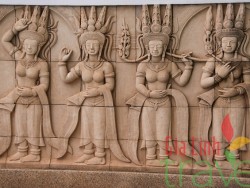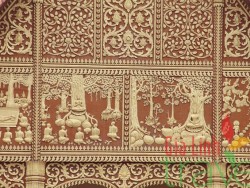Laos Art & Culture
Laos Art & Culture
Laos Art & Culture Laos Art & Culture One of the trademarks of Laos is the diversity of its people and cultures. There are a number of traditional arts and crafts that represent their way of life. Lao has a rich cultural heritage with religious art and architecture forming the cornerstone of artistic traditions. There exists across the country a plethora of distinctive monuments and architectural styles. One of the most notable structures is the That Luang, the great Sacred Stupa, in Vientiane. Its dome-like stupa and four-cornered superstructure is the model for similar monuments across Laos. Stupas serve to commemorate the life of the Buddha and many stupas are said to house sacred Buddha relics (parts of Buddha s body). Generally, Hinayana Buddhists cremate the dead body and then place the bones in the stupa, which are set around the grounds of temples, or wats. Different styles of architecture are evident in the numerous Buddhist Wats. Three architectural styles can be distinguished, corresponding to the geographical location of the temples and monasteries. Wats built in Vientiane are large rectangular structures constructed of brick and covered with stucco and high-peaked roofs. In Luang Prabang the roofs sweep very low and, unlike in Vientiane, almost reach the ground. These two styles are different from the wats of Xieng Khouang where the temple roofs are not tiered. Lao religious images and art is also distinctive and sets Laos apart from its neighbors. Another excellent example of the richness of Lao culture is in its folk music, which is extremely popular with the people throughout the country. The principle instrument is the “Khaen”, a long wind instrument, which comprises a double row of bamboo-like reeds fitted into a hardwood soundbox. The “Khaen” is often accompanied by a bowed string instrument called “saw”. These instruments, together with cymbals, drums and a wooden xylophone-like instrument, provide the delightful accompaniment to the national folk dance, “Lamwong”, in which dancers dance in couple and slowly and gracefully describe circles or “vong”. Laos handicraft TEXTILE Laos culture is best reflected in its folk crafts. Most famous of these are the incredible hand-woven textiles made from locally produced cotton and silk. The best weavings are usually associated with religious occasions. In some parts of Laos priests or priestesses use a special style of red scarf in purification ceremonies. Some observers find the Buddhist concepts of impermanence and non-substantiality reflected in the abstract and off-center designs. Contemplation of these designs can be an aid in meditation. Initially appearing as very modern and abstract, the motifs in Laos textiles include thousand year old symbols such as Tantric diamonds providing protection from evil spirits. Animal motifs include people, birds, spirits, and mythical animals such as the royal long-nosed lion, naga snakes, and the two-headed river dragon. Each of these animals has a benefical or protective meaning, although many of the old legends about them have faded from popular culture. While Laos women still wear traditional woven skirts everyday, skirts and shawls with intricate work and silk thread are reserved for special occasions such as festivals and religious ceremonies. Shawls are folded two or three times to hide the loose ends of supplementary threads and then draped over the neck with both sides hanging far down in front. A modern Lao style has developed which blends elements from several regions and favors bold designs instead of the old subtlety. Some very high quality pieces are made in the new style and also by some Lao weavers experimenting with older patterns. WOOD CRAFT Along with stone, mud, and animal parts, wood was certainly one of the first materials worked by primitive human beings. Indeed, the development of civilization was closely tied to the increasingly greater degrees of skill in working these materials. Among early finds of wooden tools and utesils in laos are the worked sticks from Champassak province in the South, gourds, wooden idols and ritual masks from Luang Namtha and Bokeo provinces in the North. Since early times, carved wooden vessels, animal traps and weaving looms are known and still are used throughout the country. Intricate wood carvings and handicrafts are of high financial value. Their value is also high with respect to their cultural importance, especially the older pieces, as many of their patterns or designs depict Lao historical events. PAPER Saa paper is made from the mulberry tree and its bark. Like many things made in Laos, it is made by hand and labor intensive. The pulp is pound by hand with a hammer. And using a screen frame that drains the water but leaves the pulp on the surface, creates the single sheet of paper – again done by hand. It is then left to dry naturally outside. Hemp fibers have also been known to be used as paper however only minimally in Laos. Generally Lao paper makers sell their modest but well known production to craft makers both in Laos and Thailand. The manufacture of saa paper follows a simple series of processes but the processes must be followed with care, are time consuming and, sometimes, can be upset by the vagaries of weather. Saa paper is made from bark which has been stripped from the young branches of the mulberry paper tree. Botanical named Broussnetia Papyrifera, the mulberry paper tree is readily grown in most soils especially those which have good, natural irrigation from a lake, river or pond. The bark is initially and thoroughly sun dried, to remove natural sap, before being baled for delivery to the saa paper factory. Then it is soaked in water, overnight or longer, until the bark is soft and pliable. The next step is to boil the “mush” for several hours this is done in huge drums in a mixture of water and caustic soda. The soda causes the fibres to breakdown even further and also bleaches them to an off-white color this is the natural color of saa paper. After the boiling is complete, the mixture is well rinsed in cold water to remove the soda solution and the remaining pulp is then placed ina “beating” machine, filled with cold water, which will separate the fine fibres from which the paper is made. The penultimate stage of manufacture is immersing a fine mesh screen (sieve) in the fibre filled water; the wooden framed screens are of uniform size and the fibres will cling to the mesh. The saa paper is now ready and the screen will be taken outside for the final process of sun drying. The sight of thousands of wooden framed screens drying in the sun can easily identify a saa paper factory.


The Calling for Rain posture of Buddha images in Lao, for example, which depicts the Buddha standing with his hands held rigidly at his side, fingers pointing to the ground, cannot be found in other Southeast Asian Buddhist art traditions. Religious influences are also pervasive in classical Lao literature, especially in the Pha Lak, Pha Lam, the Lao version of India s epic Ramayana.
